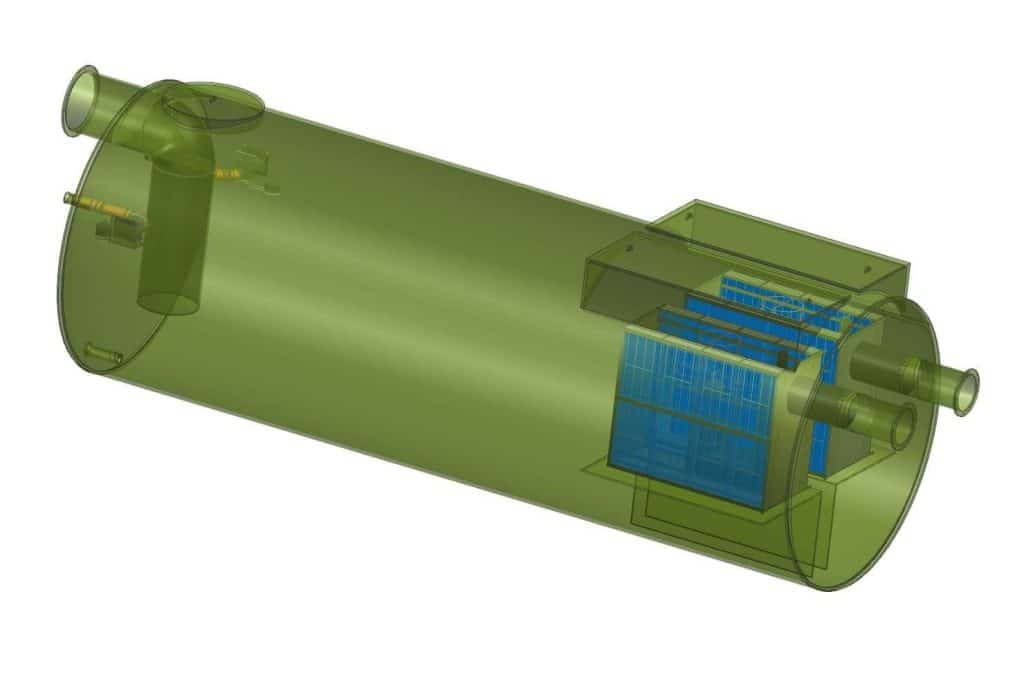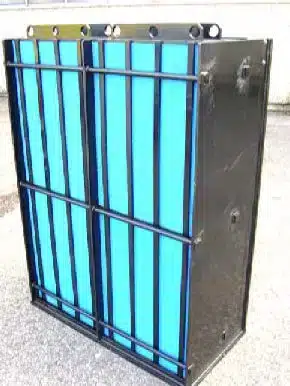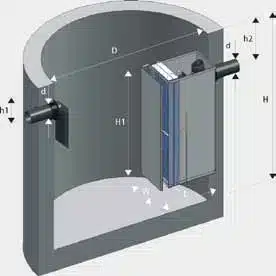Ever wondered how Massachusetts keeps our waterways safe from oil spills? The secret is underground. Massachusetts Below Ground Oil Water Separators are key to protecting our environment. But do you know the latest rules and tech?
In Massachusetts, underground oil-water separators are a must for businesses handling oil-contaminated water. These systems stop pollutants from reaching our water. With tough environmental laws, companies must use the best separation tech.
Freytech Inc. is a leader in Massachusetts with advanced below ground oil water separators. Their systems can remove up to 5 PPM of oil, beating North American limits. For harder cases, their enhanced tech gets down to 0.1 PPM for emulsified oil.
Key Takeaways
- Massachusetts below ground oil water separators are crucial for environmental compliance
- Freytech Inc. offers separators exceeding North American discharge standards
- Advanced technology can achieve 0.1 PPM efficiency for emulsified oil
- Separators effectively treat various hydrocarbons, including motor oil and jet fuel
- Proper installation and maintenance are essential for optimal performance
Understanding Below Ground Oil Water Separators in Massachusetts
Below Ground Oil Water Separators are key in managing stormwater in Massachusetts. They take out oil, grease, and petroleum from wastewater before it gets into the environment. They’re especially useful in industrial areas, dealing with oily runoff from places like storage facilities, fueling stations, and maintenance sites.
Definition and Purpose
Oil water separators are underground devices that clean wastewater. They let oil float to the top while water goes down. This way, harmful substances don’t pollute water sources. The clean water can then be safely let out or reused.
Regulatory Compliance in Massachusetts
Massachusetts has tough rules for oil separators to protect its water. Businesses must put in and keep up these systems. Following these rules makes sure the water that’s let out is safe for the environment. Keeping up with inspections and maintenance is crucial for this.
Environmental Impact and Importance
Using below ground oil water separators greatly cuts down on pollution. They stop oil and chemicals from getting into rivers, lakes, and groundwater. This is key for keeping ecosystems healthy and protecting people’s health. By using these systems, Massachusetts is a leader in taking care of the environment.
Types of Below Ground Oil Water Separators
Buried oil separators come in various designs for different needs. They are key in managing contaminated water underground. Let’s look at the main types used for treating stormwater below ground.
Cylindrical Separators
Cylindrical separators are great for underground use. Their shape fits well in tight spaces and deep areas. They’re often seen in gas stations, parking lots, and industrial areas where space is limited.
Rectangular Separators
Rectangular separators work well for vaulted underground setups. They have more surface area for separating water, making them good for large water volumes. These systems are often found in commercial and industrial areas with high water flow.
Single-Wall vs. Double-Wall Construction
Oil water separators can be single-wall or double-wall. Single-wall systems are simpler and cheaper. Double-wall ones have a leak detection space, offering more environmental safety. Companies offer both carbon and stainless steel options, letting you choose based on your project needs.
Massachusetts Below Ground Oil Water Separators: Key Features
Massachusetts Below Ground Oil Water Separators have advanced features for efficient oil-water separation. They use the latest technology for top performance and meet environmental standards.
These separators have a non-clogging coalescing technology. This technology speeds up the separation process. It makes treating contaminated water faster and more effective. Some models can remove up to 10 parts per million of free oil, which is better than the usual standards.
Maintenance is easy with these separators. They have rectangular access manholes with extensions for easy checks and cleanings. There are also fittings for vents, oil pump-out, and sludge removal for easy access during upkeep.
Safety and durability are key in these installations. Massachusetts Below Ground Oil Water Separators meet strict safety standards with UL® specifications. They often have double-wall construction and leak detection systems for extra safety.
These separators can be customized to fit specific needs. You can choose from internal coatings for better corrosion resistance, grit chambers for removing sediment, and level monitoring systems for efficient operation.
Installation Process for Underground Oil-Water Separators
Installing underground oil-water separators needs careful planning and execution. It involves several key steps for optimal performance and to follow local rules.
Site Preparation
Before starting, the site must be prepared thoroughly. This means surveying the area, marking utility lines, and getting the needed permits. The ground’s soil and water levels are checked to find the best spot for the separator.
Excavation and Placement
After preparing the site, excavation starts. A big hole is dug for the underground oil-water separator. The hole’s depth and size depend on the model and local rules. Then, a stable base is made with gravel or concrete to hold the separator’s weight.
Connection and Testing
With the separator in place, connections are made. Inlet and outlet pipes are attached for efficient flow. Electrical parts, if any, are wired as per the manufacturer’s guide. After connecting, the separator is tested thoroughly.
This includes checking for leaks, verifying water flow, and making sure it removes oil from water well.
Getting professionals to install underground oil-water separators is key for their long-term success and protecting the environment. By following these steps, businesses can make sure their systems work well and last for many years.
Maintenance and Upkeep of Subterranean Hydrocarbon-Water Treatment Systems
Keeping subterranean hydrocarbon-water treatment systems in good shape is crucial. They need regular care to work well and last longer. Let’s explore what upkeep is needed.
Checking the separator’s parts is a big part of maintenance. Look at the coalescing plates often. These plates help separate oil from water. If they’re dirty or damaged, they won’t work right. Clean or replace them as needed.
Removing built-up sludge is also key. Sludge can block the system and make it less effective. Clean it regularly to avoid this. Also, check for signs of wear or damage during these cleanings.
Many companies offer warranties on their systems. These warranties cover materials and workmanship for several years. Some even protect against corrosion for decades. Good maintenance helps you make the most of these warranties.
By taking care of your oil-water separator, you ensure it works well for a long time. This protects the environment and keeps your business running smoothly. Remember, consistent upkeep is the key to a reliable system.
Advanced Technologies in Oil-Water Separation
Recently, oil-water separation has made big strides. Now, Massachusetts Below Ground Oil Water Separators use the latest tech for better efficiency and protecting the environment. These new technologies are great at removing oil from wastewater.
Corella® Technology
Corella® technology is a big step up in oil-water separation. It uses secondary Petro Screen coalescers for amazing results. It can cut the free oil in effluent down to 10 parts per million (PPM) or less. This is way above what Massachusetts requires.
Enhanced Coalescing Systems
Some companies have made better coalescing systems. These systems can get oil levels down to 5 PPM in the water. They’re perfect for places with high environmental standards or tough oil-water mixtures.
High-LINK® Integrated Systems
High-LINK® Integrated Systems combine physical separation with digital tech. They have top-quality steel tanks and smart electronic devices. The special software gives real-time info on how well the separators are working.
This mix lets for better management of liquids. It makes sure Massachusetts Below Ground Oil Water Separators work at their best all the time.
Choosing the Right Below Ground Oil Water Separator for Your Needs
Finding the right oil water separator in Massachusetts is not easy. You must consider several factors to make the best choice for your project. Let’s look at the main points to think about.
Capacity Considerations
The size of an oil water separator is important. They range from 350 to 4000 gallons. Think about your site’s current and future needs to pick the right size. A too-small separator won’t handle enough flow, and an oversized one is a waste.
Flow Rate Analysis
Flow rates are key for effective stormwater treatment underground. Separators can handle flows from 35 to 400 gallons per minute. Check your site’s peak flow rates to make sure your chosen separator can manage it, especially during storms.
Industry-Specific Requirements
Different industries have unique needs. For example, parking lots, marinas, and truck washes need special separators. In Massachusetts, local rules also matter. Companies like Freytech Inc. and Mass Tank can guide you to the right separator for your needs.
These separators are crucial in storm water systems. They process runoff to meet the US EPA’s Clean Water Act standards. With effective oily water treatment, facilities protect the environment and dodge big fines.










